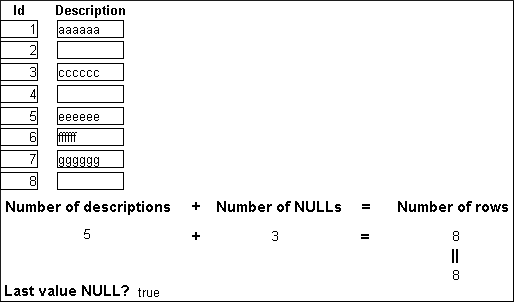A null value is a marker used to fill a place in a column where data is missing for any reason. The value might not be applicable, or it might be missing or unknown. When a database table is created, each column in the table either allows null values or does not allow them. The column or set of columns that define the primary key cannot allow null values. Sometimes it is useful to know how many null values there are in a particular column.
Suppose you are working with the Fin_code table in the Enterprise Application Sample Database. The Fin_code table has three columns:
Column |
What the column is |
Allows null values? |
|---|---|---|
Code |
Unique financial identifier (primary key) |
No |
Type |
Code type: expense or revenue |
No |
Description |
Code description: the department incurring the expense or getting the revenue |
Yes |
You create a DataWindow object using the Code and Description columns. You want to know the number of null values in the Description column.
In the DataWindow object, you create a computed field that uses functions to display the number of null values in the Description column.
For the sake of demonstrating the use of functions, the following computed fields are created in the Summary band of the DataWindow object (with text objects that tell you what information each computed field is providing):
Count(description for all)
counts the number of descriptions (that are not null);
Sum(If(IsNull(description), 1, 0))
returns a 1 if the description column is null, a 0 if the description column is not null, and then adds the total;
Count(id for all)
counts the number of IDs (which is also the number of rows);
Sum(If(IsNull(description), 1, 1))
adds the number of nulls and not nulls in the description
column (which is the total number of rows) and should match the
result of the
Count( id for all ) function;
and
IsNull(description)
evaluates whether the last row in the table has a description that is null. The return value of the IsNull function is true or false.
Here is the design for the DataWindow object.

Here is the DataWindow object showing eight descriptions, three of which are null and five of which are not null. The last description for Id=8 is null.
